
UX DESIGN FOR LOW TECH MATURITY
THE ASK
Embed digital systemic touch-points to empower cocoa farmers to sell
their
produce to Olam and allow farmers to
earn better wages.
OVERVIEW
Olam International is a food and agribusiness, supplying food ingredients, feed and fiber to thousands of customers worldwide, ranging from multi-national organizations with world famous brands to small family run businesses.
Role
Design Lead
Team
4 designers, 1 researcher
Project Status
Live
Timeline
10 months, 2017
Partners
Infosys, Bain Consultancy with Moonraft
Location
Lampung, Singapore, Bengaluru, Jakarta
PROBLEM AREA
In an effort to utilize abundant cocoa production in the Lampung region of Indonesia, Olam Cocoa set up a base there to meet with the locals and embed employees in the field. They quickly realized the potential of the area and the farmers, and also learnt of challenges. Olam wished to establish an internet based solution which would help source cocoa from farmers, take it to their appointed farmer leads and enable a supply chain of cocoa directly from farmers to their warehouse in Lampung.
MY ROLE
I led the User Experience design of the project for 8 months.
Design tasks included field research, workshops with clients and describing design decisions,
gathering business and tech requirements, helping in development, conceptualizing, wireframing,
supporting visual design, making testing protocols, documentation of UX decisions for future
collaborations and presentations.
Research
To investigate and get to know the context, a team was assembled from Olam Cocoa, Infosys, Bain Consultancy and Moonraft. Field Experts, Technologists, Strategists, Designers and a few translators gathered in Lampung, Indonesia to learn about the local culture, problem area and opportunities.
There were 11 male participants: 9 farmers and 2 contractors across age groups 35 - 50. We conducted our research by interviewing and observing the farmers by different methods like role-playing, and questionnaires and validated the observations with Olam trainers. We looked into farmers' lives, culturally and socially, their cocoa selling process, and their relationship with smart devices, among many such insights that would eventually feed into our thinking and hypothesis. We also learned about limitations like internet connectivity, lower education levels in farmers, and challenging climates.

Map location
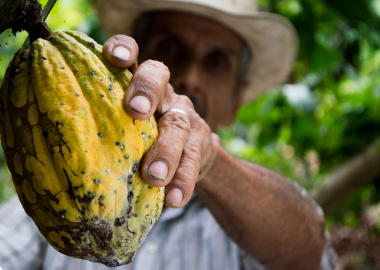
Cocoa pod
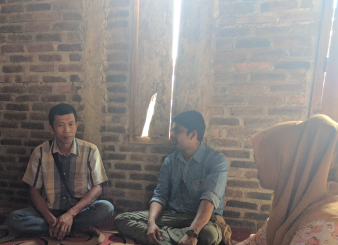
Farmer (L) with Olam representatives
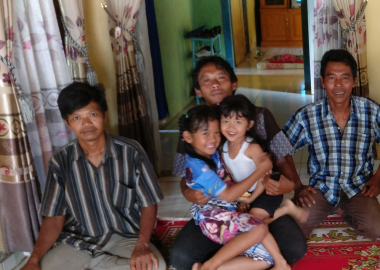
Farmer with his family members
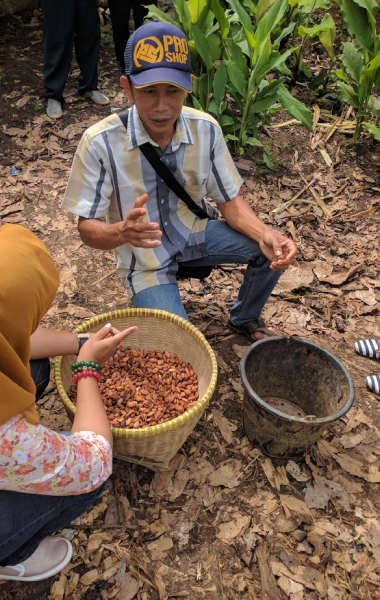
Farmer talking about drying process
IN THE FARM
We went to the cocoa fields, got bitten by a hundred mosquitos 🦟 and observed the environment in which farmers manage their cocoa production. We were taken to homes of farmers and farmer-led by Olam field experts to show the current analogue setup. We observed how farmers picked cocoa from their fields, dried cocoa in their front or back yards and how farmer leads measured the quality of wet cocoa beans that farmers brought to them to sell. Farmer leads calculated quality using refractometers and used a paper-based receipt to hand out payments to the farmers.

Farmer lead calculating price for beans
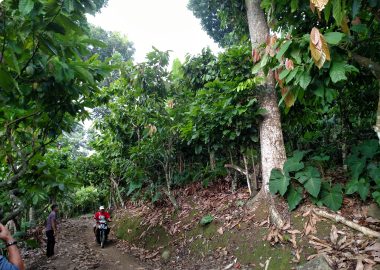
Cocoa farm
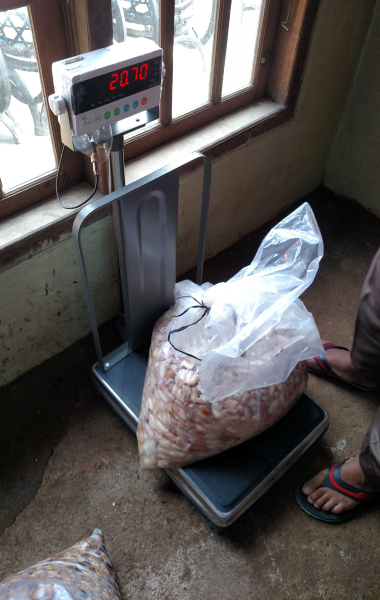
Wet cocoa beans being measured by farmer lead

Open cocoa pod in the farm
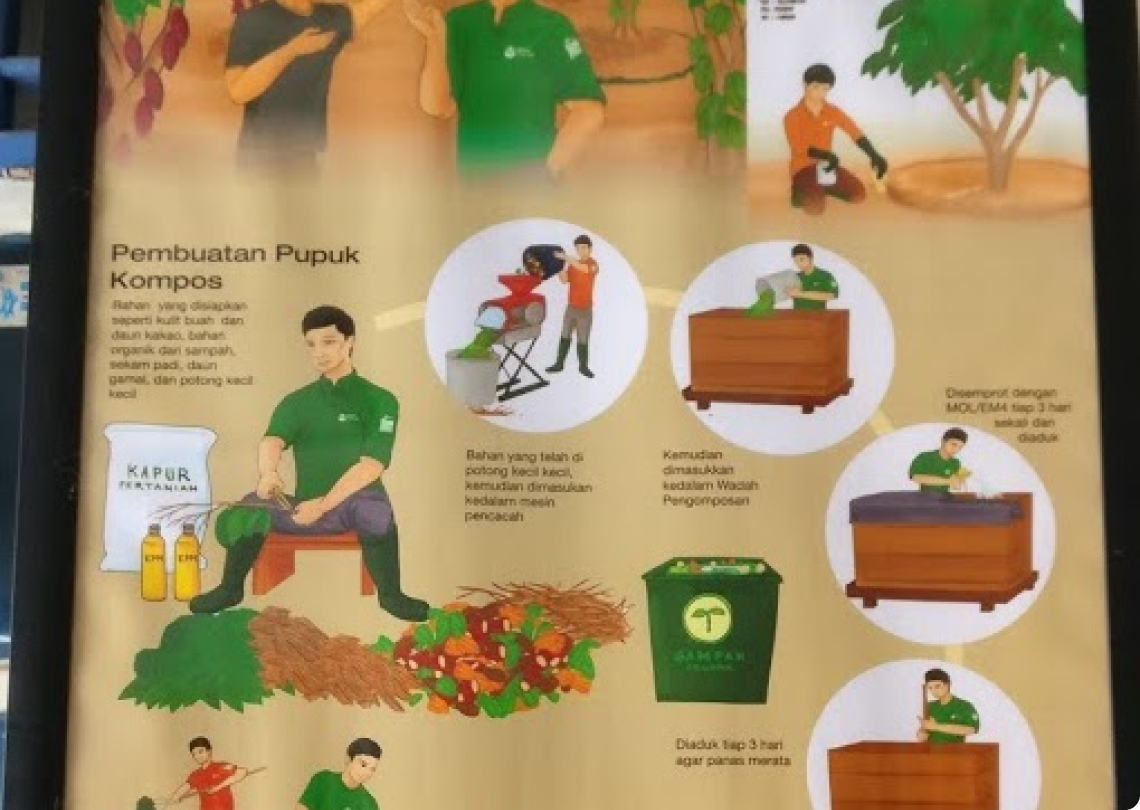
Educational content by Olam Cocoa
Challenges
The project presented numerous challenges to overcome from not only a design POV but also a business POV.
80% farmers
Farmers do not own a smart phone
Due to low wages and a remote location farmers only bought devices that brought their families entertainment or fulfilled a function. Smart phones were not popular as they were expensive and could get lost. Smart tablets were bought for family members to use whatsapp or Facebook applications at home.
35-55 male
Average age range
Young, educated and more tech-savvy people of Lampung tended to avoid farming in Lampung. Their aspirations were to move away from a village to a city and get jobs that paid well. Parents too, wanted the same for their young children. This meant that an older generation was not equipped with modern tools and devices. Adapting to an online market or selling experience is a great hill to climb on.
07-10 transactions
Average cocoa transaction per month
Farmers often only sold dry beans as they fetched a higher price. Beans were found to be drying out in the lawns of many homes in the region. Farmers would only sell low-priced wet beans when in need to make quick money.
100% cash
Cash dependency for any expenses
Many farmers had no bank accounts. They simply used the cash
they got from selling cocoa monthly. Women in the house mainly managed cash. Cash economies are
particularly hard to crack into by digitizing money as people are used to a visual and tangible
aspect of managing cash.
Apart from these main challenges, there existed a few others. Some
farmers hadn’t heard of Olam
and thus had low trust in the company. Even though middle-men had
the market in their hold with lower prices, farmers had a relationship with them and would opt to
trade with them. With Olam, they were observed to question variable cocoa pricing. Many believed
that Olam would only buy good cocoa.
TLDR CHALLENGES;
Digitalisation of a farming system that relied on middle-men, low selling price, low digital and educational exposure, low internet connectivity, and cash-only mindset.
Sapai
Sapai is a 43 year old farmer who lives in Wiyono, Lampung with his wife and kids. All his relatives live in proximity to his house. He has 1 hectare of inherited land. Farmers like Sapai sell dry cocoa every 2-3 days and in case they want urgent money they sell wet cocoa. Sapai had little to no smart phone exposure, and his family uses a tablet for entertainment only. He expects to be fairly compensated for his produce.
He worked for a company forfew years but did not like the job as he was constantly stressed about being answerable to his seniors. He came back and started helping his father in the field. A year later he got married. After his marriage he got to know from TV that market price for cocoa is very good. He started looking for the means to harvest cocoa along with his cousin,Sansuri. He and Sansuri enquired about it from other farmers as they felt that they will be able to make a lot of money with cocoa as it is mostly eaten by Europeans, and it’s demand will never go down.He wanted his children to get a good education so that they could get a good job. It is ok if they don’t want to work on the farm, they can hire someone to work for them; but he didn’t wish to sell his farm.
Sapai only started to trust Olam when sometime ago they saw the bean production drop. They asked the farmers nearby and tried many solutions but nothing seemed to work. They tried solutions recommended by Olam and saw the results thus increasing trust.

Sapai at his home in Lampung, holding his primary device

RESEARCH INSIGHTS
By interviewing farmers, making observations and synthesizing insights them we established key research pillars that helped us create ways to tackle the problems faced by farmers.
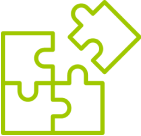
Collectivist Mindset
Farmers were observed to value
their community. Neighbors come
first
and help goes out to everyone
who needs it.
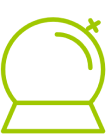
Predictability of circumstances
Farmers like to have a certain
amount of control in their farms and
community.
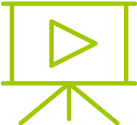
Experiential Learning
Due to low education in the region
farmers learnt about techniques and
tricks better with educators and
multimedia.

Upward Mobility
Many farmer parents want their
children to leave Lampung and
establish themselves in big cities like
Jakarta.
Workshops
Throughout the project we had numerous workshops and field visits with the stakeholders of Olam, Bain and Infosys in Lampung, Jakarta & Bangalore highlighting various requirements, achievable targets, brainstorming on tackling process issues and finalizing timelines. We also had many online workshops to plan sprints for phase 1.

Workshop at Olam, Jakarta

Workshop at Infosys, Bangalore

Workshop at Moonraft Innovation Labs
DESIGN FOR PEOPLE
Four profiles were decided for the digital system. These 4 profiles, starting with the farmer had varied levels of tasks and complexities. An additional role of an administrator would oversee all the operations was added for phase 2.

The Farmer

Farmer Lead

Pick up Driver

Warehouse Incharge
EXPERIENCE PRINCIPLE
With insights from research, we derived 4 core principles for the design of the MVP phase of the project. It was important that farmers end up trusting the Olam digital experience while keeping the experience itself simple enough as the farmers did not have a lot of exposure to mobile devices and applications. The application had to be designed in their native language Bahasa. The experience would have to give back control to the farmers by offering key decision moments in the sale experience all the while connecting the 4 roles that made the flow of cocoa from farm to warehouse seamless and with fewer complications.


Design Concept
The first draft enabled the farmer to raise a single intent to sell all the types of beans. Farmers had to enter the weight of each type of bean they selected to sell. The process also required them to choose a lead farmer to sell to. Lastly, it asked them to select the mode of payment - cash or bank.

Cocoa’s journey

Cocoa Farmer
Mobile Application
The farmer application enabled the farmer to raise a single intent to sell all the types of beans. Farmers had to enter the weight of each type of bean they selected to sell. The process also required them to choose a lead farmer to sell to. Lastly, it asked them to select the mode of payment - cash or bank.

TWO APPROACHES
 SELL ALL TYPES OF
BEANS AT A TIME
SELL ALL TYPES OF
BEANS AT A TIME
The first approach let farmers sell all types of beans in a single order by scheduling a drop-off with a farmer lead. The idea here was to enable selling as many beans as possible this eliminating the need to use the app repeatedly and get paid for all of the cocoa. The downside was a long task length and interaction heavy.

Farmer wireframes first approach
 SELL ALL TYPES OF
BEANS AT A TIME
SELL ALL TYPES OF
BEANS AT A TIME
The other approach let the farmer sell only one bean type at a time.This was a shorter taskflow and the intention was to keep the focus on scheduling an order because of the low tech exposure levels of the farmers in the program. The downside was that there would be many orders from each of the farmers for the farmer lead. This approach was selected to keep things simple and functional.

Farmer wireframes second approach
Farmer Lead
Mobile Application
The first draft enabled the Farmer Lead to receive intents and
categorize them by scheduled orders and completed orders. Farmer Lead would select the farmer and
input the quality of the cocoa brought by the farmer.
The farmer lead could select any
number of bean types that the farmer would have brought along. Thus the process was a fluid in
terms of selection and input. After input, the back end would calculate the price of cocoa and the
farmer lead would send a notification to the farmer. The farmer upon accepting the offer would
receive payment - in cash or the bank.


Farmer Lead wireframes
Components
Components were designed specifically for farmers and farmer leads to use out in the sun. The visual design is based on Olam’s brand guidelines. Although there were no digital mobile guidelines, print guidelines to were adapted to digital. Focus was on custom designing components to suit the needs of farmers with little to no smartphone exposure and creating bespoke elements for more complex tasks for the farmer lead.


User Testing with Farmers
6 FARMERS.
Applications were translated in Bahasa, the local language in Indonesia. Testing was held remotely with the help of a moderator from Olam. Farmers were invited to Olam’s warehouse where they shown the prototypes. Insights from the testing led to changes to the designs for both farmer and farmer lead applications.


Testing with moderator at Olam Warehouse, Lampung
INSIGHT 01
Farmers tapped on anything they deemed relevant. This was most evident with the bean prices on the dashboard. It was observed that some farmers tapped on the price (figure A).
ACTION
Prices were made into buttons thus making the home screen the first screen in the scheduling process (figure B). Farmers felt more confident in
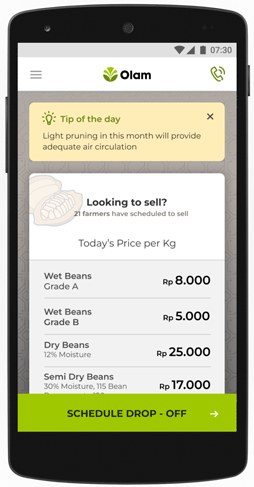
Figure A
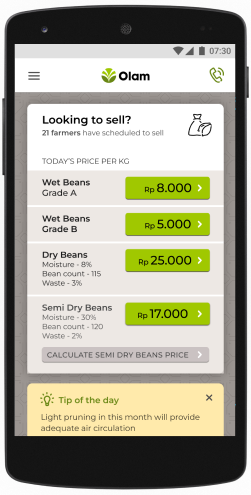
Figure B
INSIGHT 02
Some participants thought that they were supposed to call the Farmer Lead to find out if the beans would picked up or would they have to drop it (figure C). The extra step of showing the farmer lead screen was confusing farmers.
ACTION
This led to surmising the flow into 2 screens - entering the weight of selected beans and selecting a payment method (figure D).

Figure C

Figure D
INSIGHT 03
The confirmation card of the order was confusing to the farmers and multiple orders couldn’t be stacked on the screen.
ACTION
A better Information hierarchy and reallocation of secondary actions in drill-down navigation helped keep the interface clean and
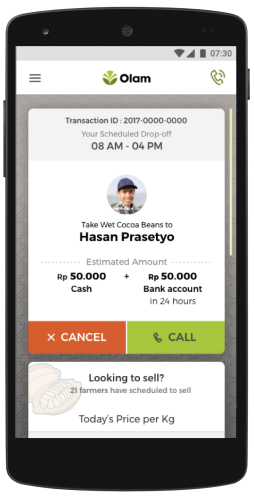
Figure E
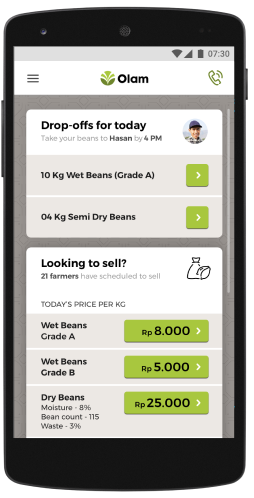
Figure F
INSIGHT 04
Most farmers expected to have a 100% cash option in addition to 50-50% cash-bank and 100% bank option.
ACTION
Added incentives to sign up for banks as a way to push official payment methods.
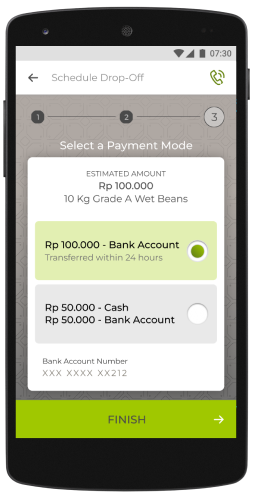
Figure G

Figure H
Usability Testing with Farmer Leads
4 Farmer Leads
INSIGHT 01
Farmer leads were confused by the fluid nature of inputs of the bean types (figure I). There was problem in addressing multiple bean types by the same farmer.
ACTION
The process was streamlined to be more objective (figure J). The Farmer lead now could only process one bean type at a time. This gave rise to better records and price assessments thus reducing cognitive load.
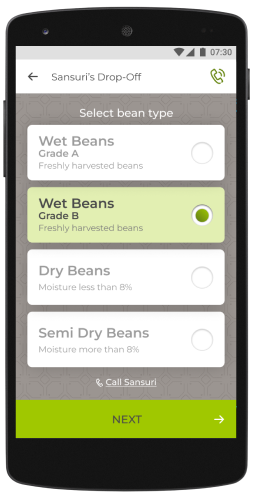
Figure I
INSIGHT 02
The act of input was challenging as typical touch sizes didn't apply to farmer leads. We deemed this the Fat Finger Syndrome.
ACTION
Touch sizes were increased to accommodate finger sizes of the farmers and farmer leads.

Figure J
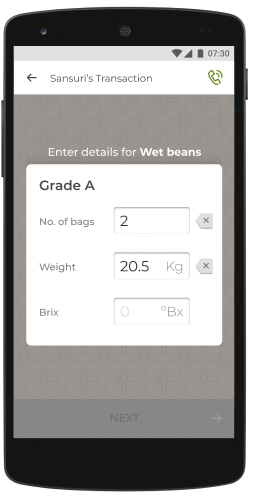
Figure K
INSIGHT 03
During testing some farmers expressed concerns about using an app as they don't have smart phones at all. At this stage Olam and the design assessed that it might make sense to let the Farmer Lead raise an intent on the farmer’s behalf.
ACTION
This led us to design a new feature in the next phase of the application enabling a farmer to sell their cocoa without having a smart phone. The farmer lead could buy beans at a moments notice.
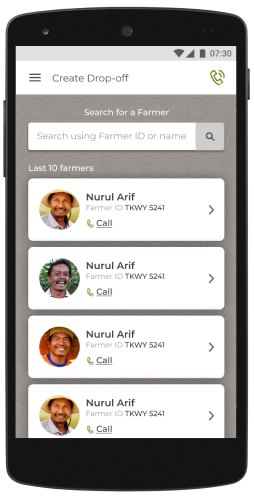
Figure L
Pick up driver
Mobile Application
This part of the system was primarily meant for navigating to the location of farmer leads operating in the area. A more challenging aspect of the application was to design a handshake between the farmer lead and the truck driver.


Handshake between Farmer lead and Pick up Driver
The pick up driver would have to measure each of the transactions IDs and enter the weight of the cocoa in the interface. The system would flag any weight discrepancies and only upon a confirmation from the farmer lead would the entire batch report be saved for the administrator.
Warehouse incharge
Mobile Application
This role was intended to offboard the collections from a few pick up drivers. This set of interactions borrowed from the farmer lead and pick up driver - with one change. Instead of weighing all the bags, a weigh bridge is used to weight entire shipment.

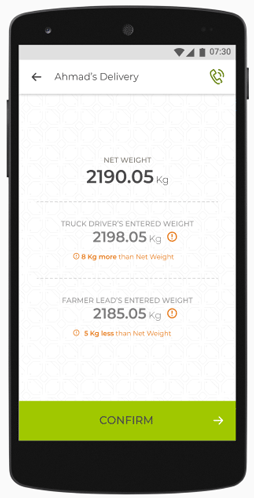
Handshake between Pick up Driver and Warehouse Incharge
Warehouse incharge asks the truck driver to weigh the entire load comprising of various farmer leads. The handshake between these two roles would kick off the next stage of cocoa BIN management which is taken care of by the administrator.
Phase 2
Phase 2 of the project was meant to focus on implementing testing insights from phase 1, new features proposed, and creating applications for other roles that enabled the cocoa’s journey such as Truck driver, Quality Inspector, Warehouse Incharge and the Administrator at the warehouse.
Features for farmer application included:
-
Selecting farmer lead from a list
-
Offline scenarios
-
Sign up and account limitations based on Indonesian identification
-
Editing profile details
-
Adding bank account
-
Loans for devices
-
Incentive payouts
Features for farmer lead application included:
-
Signing up farmers
-
Farmers roster
-
Ledgers for payments
-
Truck driver app integration
-
Verifying Farmer identification
-
Receiving cash reimbursements


Related projects

